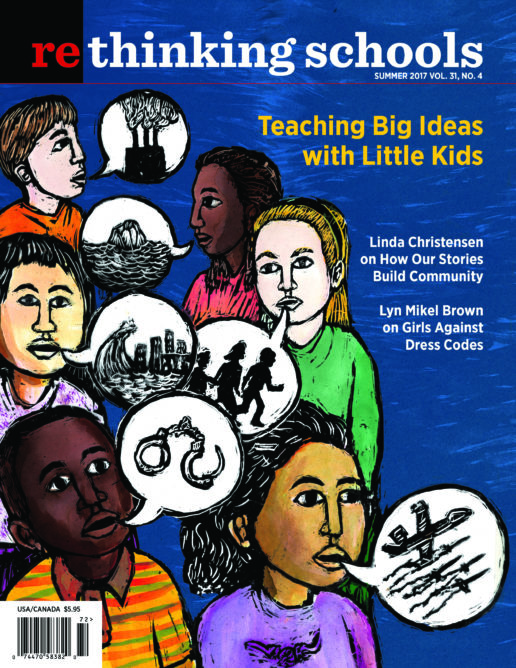Our picks for books and other resources for social justice teaching 31.4
Picture Books
The Aida Camp Alphabet
By Children of Lajee Center, Aida Refugee Camp, Bethlehem, Palestine
Lajee.org
Project coordinator: Amahl Bishara
2015, unpaginated
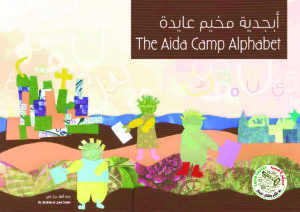
The Boy and the Wall
By Amahl Bishara, illustrated by Lajee Center children
Undated, unpaginated
The Aida Camp Alphabet is no typical children’s alphabet book. For one thing, it’s in English and Arabic, and is a lovely introduction — for both kids and adults — to the Arabic language. But it is also an introduction to children’s lives under Israeli occupation in the West Bank. “Baa is for beit, home. We live in Aida Camp now, but our grandparents were born in stone houses I’ve never seen, in a village just a few mountains away.” And: “Laam is for lajee. Being refugees means we lost our homes but that we have the right to return to them. We carry old keys and make new ones to express our rights.” The Lajee children’s colorful collages illustrate the narration. Amahl Bishara’s short introduction offers a concise portrait of the conditions under which this book was created.
Like The Aida Camp Alphabet, The Boy and the Wall is a bilingual Arabic-English book describing experiences in the Aida Refugee Camp from the perspective of children in the Lajee Center. It describes the poignant and poetic conversation between a son and his mother, following the 2004 construction of the Israeli separation wall in the West Bank, which divided children from where they used to play and explore. “The boy thought about what he could do to help his community overcome the wall, and he said to his mother, ‘Perhaps I will become an onion patch, so that when the soldiers throw tear gas, my friends can be soothed by my onions,’ said the boy. ‘If you become an onion patch,’ said his mother, ‘I will become the warm, rich soil in which you grow.'” As we discuss in the editorial in this issue of Rethinking Schools, taught sensitively, young children can think about hard issues. These books are valuable resources.
Stepping Stones: A Refugee Family’s Journey
By Margriet Ruurs
Illustrated by Nizar Ali Badr
(Orca Book Publishers, 2016)
28 pp.
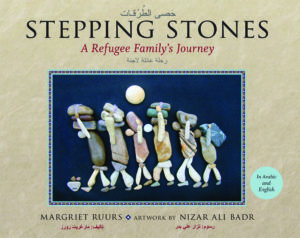
This bilingual children’s picture book (English and Arabic) is worth reading for the illustrations alone. The three-dimensional characters, made from beach stone by Syrian artist Nizar Ali Badr, are so expressive and exquisite that they tell a story of their own. Badr conveys the plight of refugees, although he himself has never left Syria. He explains, “How could I leave the country that gave to humanity the world’s oldest writing, the cuneiform alphabet?” He adds that he feels the “deepest love for my homeland that is suffering from the appalling injustice inflicted upon it by alien global elites.” Author Margriet Ruurs has added a story of a young girl who also loves Syria, yet is forced to flee when the bombs fall close to her family home. The text conveys the beauty of daily life in her homeland, the pain of leaving, and the fact that the journey is so dangerous that not all travelers survive. The realistic nature of the book then shifts when the refugees arrive in another country, welcomed with open arms. Adults reading the story aloud can explain that while this is how it should be, sadly it is not the norm.
Films
Una Vida, Dos Países
Documentary film, 2016
Dir. Tatyana Kleyn
www.unavidathefilm.com

Between 2009 and 2014, 1 million Mexicans — including U.S.-born children — left the United States for Mexico. This bilingual documentary, available online, documents stories of young people who returned to Mexico after growing up in the United States. It captures the tough choices their families had to make, often going back to their home country because of ill or aging parents or due to the harsh realities of immigrant life in the United States. Young people share the complexities of being caught between cultures, languages, and countries, providing a powerful counter-narrative to current anti-immigrant stereotypes and misconceptions. Just 30 minutes long, this documentary is perfect for sharing with students, and accompanying curriculum materials are available on the website.
Young Adult Books
By Angie Thomas
(Balzer & Bray, 2017)
464 pp.
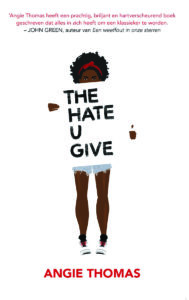
This is the young adult book that every high school student, teacher, and parent in the country should read. In her first novel, author Angie Thomas of Jackson, Mississippi, brings the reality of U.S. racism to readers through the story of a 16-year-old girl who witnesses the fatal police shooting of her friend. Thomas weaves in an incredible amount of history into this page-turner of a book. A New York Times best seller, it can generate rich classroom discussions about the Black Lives Matter movement in historical context and the need for collective action for radical change.
Piecing Me Together
By Renée Watson
(Bloomsbury, 2017)
272 pp.
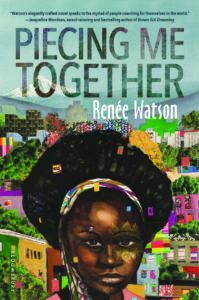
“I am learning to speak. To give myself a way out. A way in.” The opening words from Piecing Me Together set the stage for a journey of discovery for Jade, a young Black high school student searching for a way out of her neighborhood, her situation, and her own mind. In the novel, Jade struggles with how opportunities presented to her affect how she sees her friends, her family, and herself. “I know what it’s like to feel kind of guilty for being the one to get what others don’t have access to….When I started going to St. Francis, my friends would ask me to tell them what St. Francis was like … they looked like they were in awe. But sometimes there was sadness in their eyes.” These contrasting feelings of pride and guilt are expressed in the art produced by characters in the book. While Jade’s collages attempt to cobble together a fuller identity, her friend Lee Lee’s poetry tries to reconcile the split between celebrating the beauty of her Blackness and society’s attempt to beat it out of her. In Piecing Me Together, Renée Watson uses art as a means for these characters to piece together their own identities in a world that wants to define it for them.
Policy
The Color of Law: A Forgotten History of How Our Government Segregated America
By Richard Rothstein
(Liveright, 2017)
336 pp.
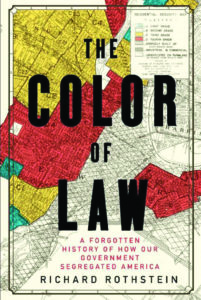
Most of us learned that segregation in the South was de jure and in the North it was de facto. McDougal Littell’s textbook, The Americans, says, “African Americans found themselves forced into segregated neighborhoods.” But the passive voice in this passage hides the enforcer. In The Color of Law, researcher Richard Rothstein proves beyond a doubt that segregation in the North was also de jure, and that African Americans did not just find themselves forced into segregation — the federal government forced them to live in specific, low-income communities. While written for higher ed and above, sections could be read in high school with the invitation for students to uncover the housing history in their own communities.
Just News
UCLA Center X
centerx.gseis.ucla.edu/blog/
It’s not easy sorting through the forest of blogs, newspapers, magazines, radio reports, and other media for critical reporting about schools and society. Thankfully, UCLA’s Center X produces an excellent — and free — weekly collection of timely education-related articles called Just News. Categories include “Teaching, Leading, and Social Justice,” “Language, Culture, and Power,” “Whole Children and Strong Communities,” “Access, Assessment, and Advancement,” “Inequality, Poverty, and Segregation,” and “Public Schools and Private $.” Just News editors draw stories from a broad range of media. It’s a treasure trove of news and insight that social justice proponents will find invaluable.

